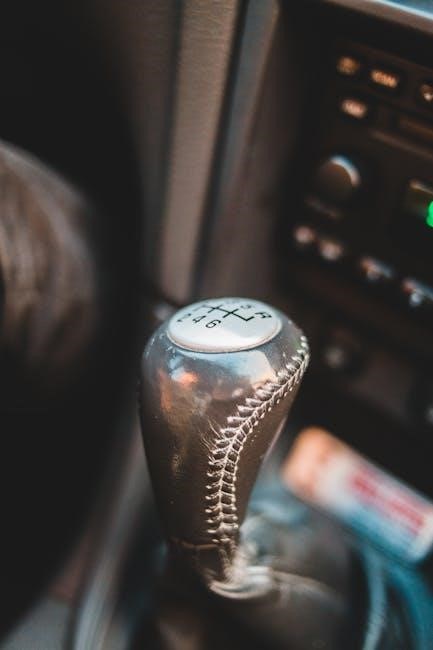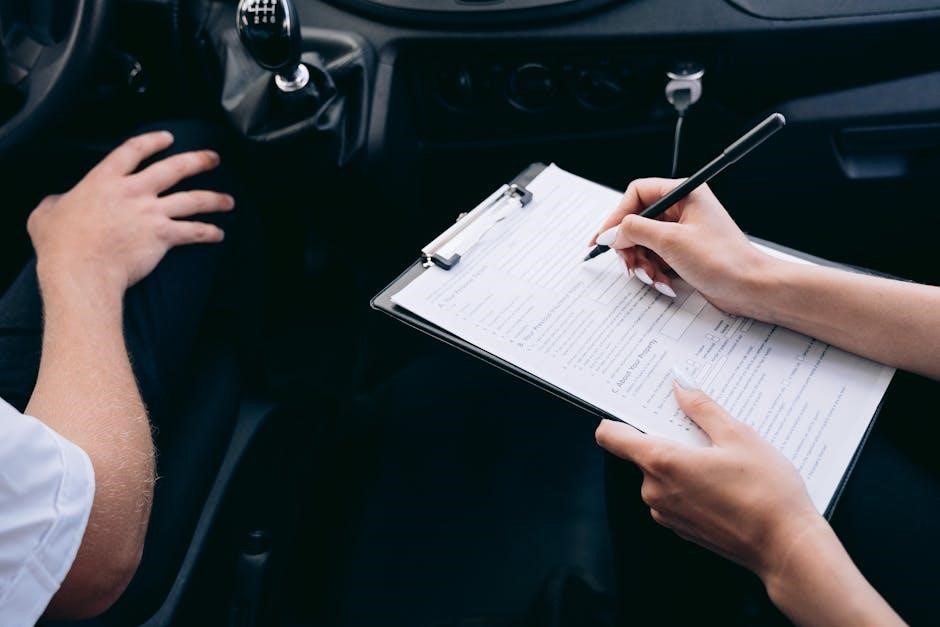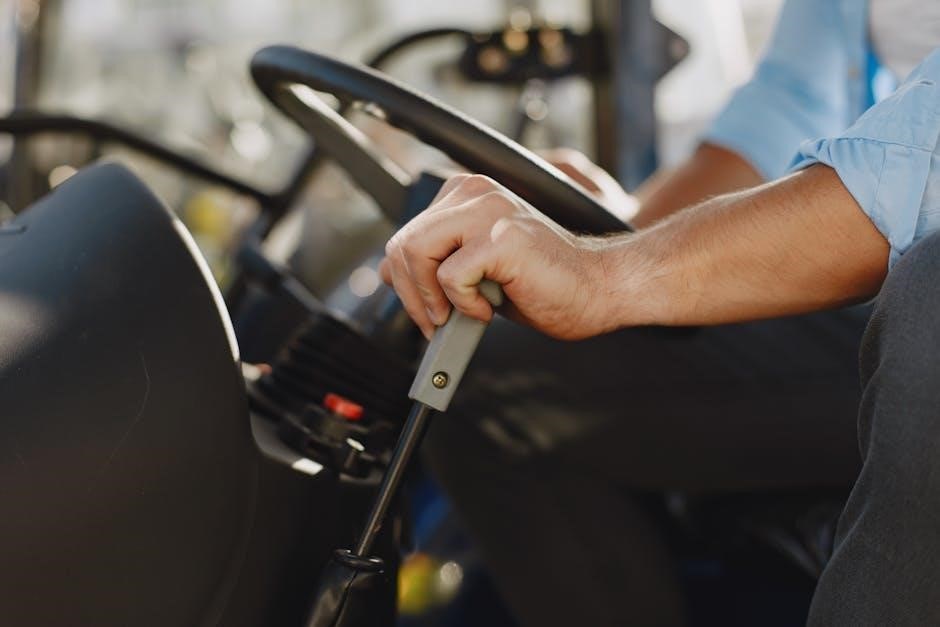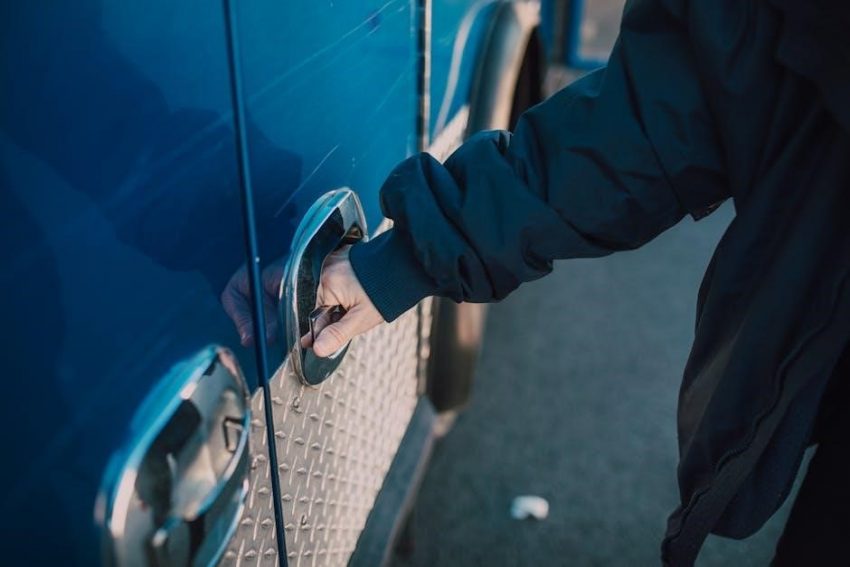The Utah Driver’s Manual, a collaboration between AAMVA and the Utah Driver License Division, outlines rules for operating vehicles, including bicycles, to ensure safe driving practices.
1.1 Overview of the Manual’s Purpose and Structure
The Utah Driver’s Manual is a comprehensive guide designed to educate drivers on state-specific traffic laws, safe driving practices, and license requirements. It is structured to cater to both new and experienced drivers, providing clear instructions on road rules, signs, and safety measures. The manual is divided into sections, including rules of the road, safe driving practices, driver’s license requirements, DUI laws, and motorcycle-specific rules. Each section is detailed to ensure drivers understand their responsibilities and how to navigate Utah’s roads safely. The manual also includes resources for preparing for the written knowledge test and understanding eligibility criteria.
1.2 Importance of the Manual for Utah Drivers
The Utah Driver’s Manual is essential for all drivers, providing a clear understanding of traffic laws, safety practices, and license requirements. It serves as a primary resource for new drivers preparing for the written knowledge test, ensuring they grasp fundamental driving principles. For experienced drivers, it offers a refresher on updated laws and safe driving techniques. The manual’s structured approach helps drivers navigate Utah’s roads responsibly, reducing accidents and promoting a safer driving environment. By adhering to the guidelines outlined, drivers contribute to a community-focused approach to road safety and legal compliance.

Rules of the Road in Utah
Utah’s rules of the road include traffic signals, speed limits, and right-of-way regulations to ensure safe driving practices. Special laws apply to bicyclists and motorcyclists, promoting road safety.
2.1 Traffic Signals and Signs
Traffic signals and signs in Utah are designed to regulate the flow of traffic and ensure safety. Drivers must obey all traffic signals, including red, yellow, and green lights, as well as pedestrian signals. Regulatory signs, such as stop signs and yield signs, must be followed to avoid accidents. Warning signs, like curve ahead or pedestrian crossing signs, alert drivers to potential hazards. Guide signs provide directional information to help navigate roads. Adhering to these signals and signs is crucial for maintaining traffic order and reducing collisions. Utah state law requires compliance with all traffic signals and signs.
2.2 Speed Limits and Right-of-Way Rules

Speed limits in Utah vary based on road type and location, with urban areas typically having lower limits than rural highways. Drivers must adhere to posted speed limits to ensure safety. Right-of-way rules are essential for smooth traffic flow. At intersections, drivers must yield to traffic already in the intersection or approaching from the right. When encountering a four-way stop, the driver who arrives first proceeds first, or the vehicle on the right has priority if arrival is simultaneous. Understanding and following these rules is critical to preventing accidents and maintaining orderly traffic.
2.3 Special Laws for Bicyclists and Motorcyclists
Bicyclists and motorcyclists in Utah must follow specific laws to ensure safety. Bicyclists are required to obey the same traffic laws as vehicles and must use hand signals for turns. Motorcyclists are permitted to lane filter in certain conditions, but safety guidelines must be followed. Both groups must wear protective gear, with helmets mandatory for minors on bicycles and required for all motorcyclists. Additionally, Utah’s strict DUI laws apply to bicyclists and motorcyclists, with a 0.05 BAC limit. Understanding these rules is essential for safe coexistence on Utah roads.

Safe Driving Practices
Safe driving practices in Utah emphasize defensive driving, staying alert, and maintaining a safe distance. Always be prepared for emergencies and follow traffic rules to minimize risks.
3.1 Defensive Driving Techniques
Defensive driving techniques in Utah involve staying alert, maintaining a safe following distance, and anticipating the actions of other drivers. Always scan the road ahead and be prepared to react. Avoid distractions like texting or eating while driving. Use mirrors and check blind spots regularly. Adjust your speed according to road conditions and weather. Be cautious of aggressive drivers and never engage with them. Signal your intentions clearly and use headlights appropriately. Defensive driving helps minimize risks and ensures a safer environment for all road users.
3.2 Handling Emergency Situations on the Road
In case of an emergency, stay calm and move to a safe location if possible. Use hazard lights to alert other drivers. If your vehicle breaks down, turn on emergency lights and stay inside with seatbelts fastened. Avoid sudden movements and keep a phone nearby for emergencies. Know how to use a fire extinguisher and when to call for help. Always carry an emergency kit with essentials like water, a flashlight, and first aid supplies. Familiarize yourself with Utah’s roadside assistance options to ensure safety and quick resolution during unexpected incidents.
3.4 Roundabouts and Their Use in Utah
Roundabouts are circular intersections designed to improve traffic flow and reduce accidents. When approaching a roundabout, yield to traffic already in the circle. Signal your exit before leaving. Always travel counterclockwise and maintain a safe speed. Do not stop or reverse inside the roundabout. Bicyclists and motorcyclists should use designated lanes or follow traffic signals. Roundabouts are common in Utah to enhance safety and efficiency. They reduce congestion and lower accident rates compared to traditional intersections. Familiarize yourself with roundabout rules to navigate them confidently and safely.

Driver’s License Requirements
Obtaining a Utah driver’s license requires meeting eligibility criteria, completing an application, passing a vision test, and successfully taking a written knowledge and driving test.

4.1 Eligibility and Application Process
To apply for a Utah driver’s license, residents must meet specific eligibility criteria, such as age requirements and legal residency. The process begins by completing an application form, which can be accessed online or at a local Driver License Division office. Applicants must provide required documents, including proof of identity, residency, and Social Security number. Minors under 18 may need parental consent. Vision and written knowledge tests are mandatory for first-time applicants. The manual outlines detailed steps and necessary documents to ensure a smooth application process, helping applicants prepare effectively for obtaining their license.
4.2 Written Knowledge Test Overview
The written knowledge test assesses understanding of Utah driving laws, road signs, and safe driving practices. It includes questions on traffic signals, right-of-way rules, and defensive driving techniques. The test is required for first-time applicants and focuses on ensuring familiarity with state-specific regulations. Practice questions are available to help prepare, covering topics like speed limits and special rules for cyclists and motorcyclists. Passing the test demonstrates a basic grasp of Utah’s traffic rules, which is essential for obtaining a driver’s license and operating a vehicle safely on public roads.
4.3 Vision and Medical Requirements
In Utah, applicants for a driver’s license must meet specific vision and medical standards to ensure safe driving abilities. Vision tests assess acuity and peripheral vision, with corrective lenses permitted if needed. Certain medical conditions may require evaluation by a healthcare professional. The Utah Driver License Division evaluates these requirements to ensure public safety. Applicants with severe visual impairments or chronic medical conditions may face restrictions or disqualifications. Periodic medical assessments may be required for license renewal, particularly for older drivers or those with health conditions that could impact driving skills. Compliance with these standards is mandatory for obtaining and maintaining a valid license.

Utah’s DUI Laws
Utah enforces a strict 0.05 blood alcohol content (BAC) limit, the lowest in the U.S., applying to all drivers, including bicyclists. Violations result in severe penalties.
5.1 Strict DUI Limits (0.05 BAC)
Utah enforces the strictest DUI law in the U.S., with a blood alcohol content (BAC) limit of 0.05. This applies to all drivers, including bicyclists. Operating a vehicle or bicycle with a BAC of 0.05 or higher is illegal. Penalties include fines, license suspension, and potential jail time. The law aims to reduce impaired driving incidents and enhance road safety. Drivers must be aware of this lower threshold compared to other states, ensuring responsible behavior behind the wheel; Utah’s strict enforcement underscores its commitment to preventing alcohol-related accidents and protecting all road users.

5.2 Consequences of Driving Under the Influence
Driving under the influence (DUI) in Utah carries severe penalties. First-time offenders face fines, license suspension, and potential jail time; Repeat offenses result in harsher penalties, including longer license revocation periods and mandatory ignition interlock devices. Additionally, a DUI conviction can impact insurance rates and employment opportunities. Utah’s strict DUI laws aim to deter impaired driving and protect road users. The consequences underscore the importance of adhering to the state’s 0.05 BAC limit and promoting responsible driving habits to ensure public safety.
5.3 Impact on Bicyclists and Motorcyclists
Utah’s strict DUI laws apply to all road users, including bicyclists and motorcyclists. Operating a bicycle or motorcycle under the influence of alcohol or drugs carries the same penalties as driving a car, including fines, license suspension, and potential jail time. Bicyclists and motorcyclists are also at higher risk of accidents due to impaired judgment and reduced coordination. Utah’s 0.05 BAC limit aims to protect these vulnerable road users, emphasizing the importance of sober riding. DUI convictions can also lead to increased insurance rates and long-term consequences for motorcyclists and bicyclists.

Motorcycle-Specific Rules
Motorcycle-specific rules in Utah cover lane filtering, safety gear requirements, and traffic laws. Helmets and eye protection are mandatory for all riders to ensure safety on roads.
6.1 Lane Filtering and Safety Guidelines
Lane filtering in Utah is legal under specific conditions, allowing motorcyclists to pass slowed or stopped traffic. Riders must do so at speeds no more than 45 mph and only between two lanes moving in the same direction. Safety guidelines emphasize avoiding lane filtering in school zones, construction areas, or where prohibited. Motorcyclists should signal intentions, maintain visibility, and check mirrors before maneuvering. Always stay alert to surrounding vehicles and road conditions to minimize risks. Proper adherence to these guidelines ensures safer lane filtering practices for motorcyclists and other road users.
6.2 Required Safety Gear and Equipment
The Utah Driver’s Manual emphasizes the importance of safety gear for motorcyclists. Riders are required to wear Department of Transportation (DOT)-approved helmets, which must have a visor or goggles for eye protection. Gloves, sturdy boots, and durable pants or jackets are also recommended. Additionally, motorcycles must be equipped with functional brakes, a muffler, and turn signals. Reflective materials on clothing or the bike are encouraged to increase visibility. Regular checks of tire pressure, brakes, and lights are essential to ensure safe operation. Compliance with these guidelines helps reduce the risk of accidents and enhances overall road safety for motorcyclists.
6.3 Motorcycle-Specific Traffic Laws
Motorcyclists in Utah must adhere to specific traffic laws to ensure safety. Lane filtering is permitted under certain conditions, but riders must maintain visibility and caution. Motorcycles are allowed to pass on the right only when safe and legal. Riders must follow all traffic signals and signs, maintaining a safe distance from other vehicles. Utah law prohibits carrying passengers unless the motorcycle is equipped with a designated seat and footrests. Additionally, motorcyclists are required to use headlights during daylight to increase visibility. Compliance with these laws is crucial to reduce accidents and enhance road safety for all users.

